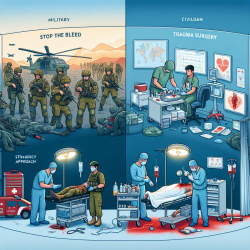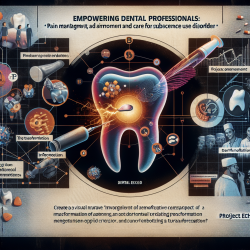Introduction
In the wake of increasing mass casualty events, both natural and man-made, there is an imperative need for practitioners to enhance their skills and strategies in trauma care. The research article "Response to mass casualty events: from the battlefield to the Stop the Bleed campaign" offers valuable insights into how military practices can be adapted for civilian use. This blog explores how practitioners can leverage these insights to improve trauma care outcomes.
Lessons from the Battlefield
The research underscores several key lessons from combat casualty care that have profound implications for civilian trauma response:
- Balanced Transfusion Protocols: The military's balanced transfusion protocol, which involves a specific ratio of blood products, has been shown to reduce mortality and conserve resources. Civilian trauma centers can adopt these protocols to improve patient outcomes.
- Use of Tourniquets: The Combat Application Tourniquet (CAT) has demonstrated significant survival benefits in major limb trauma. Practitioners should be trained in the application of tourniquets to control hemorrhage effectively.
- Tactical Combat Casualty Care (TCCC): This comprehensive training program focuses on rapid hemorrhage control, relief of tension pneumothorax, and airway obstruction management. Civilian practitioners can benefit from incorporating TCCC principles into their training.
Adapting Military Practices to Civilian Settings
While the military context differs from civilian settings, the principles of combat casualty care can be adapted to enhance civilian trauma response:
- Goal-Directed Hemostatic Resuscitation: Utilizing thromboelastography (TEG) to guide resuscitation efforts can improve survival rates while preserving blood products.
- Dual Command Structure: Implementing a dual command structure in hospitals, with one physician overseeing the emergency department and another managing the operating room, can streamline patient flow and improve communication.
- Community Training: Initiatives like the "Stop the Bleed" campaign aim to educate the public on hemorrhage control techniques, empowering them to act as immediate responders in mass casualty events.
Encouraging Further Research
While significant progress has been made, there are still gaps in knowledge that require further research. Areas such as prehospital control of intracavitary bleeding and the management of head injuries remain critical. Practitioners are encouraged to engage in ongoing research and training to stay abreast of the latest developments in trauma care.
Conclusion
By integrating battlefield insights into civilian trauma care, practitioners can enhance their preparedness and response to mass casualty events. Continuous learning and adaptation are essential to improving outcomes and saving lives. To delve deeper into the research and its implications, practitioners are encouraged to read the original research paper: Response to mass casualty events: from the battlefield to the Stop the Bleed campaign.










